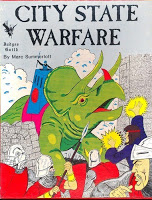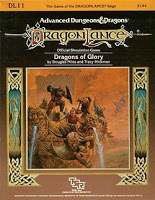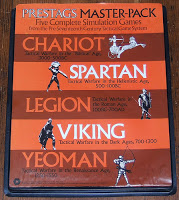The wargaming antecedents of the modern RPG industry are well known. Indeed, the gaming industry, as such, was dominated by the companies SPI and Avalon Hill through the mid-1980’s, before the TSR Dungeons & Dragons juggernaut overwhelmed them and TSR actually absorbed SPI. Indeed, both Avalon Hill and SPI took stabs at entering the RPG market, albeit not very daring maneuvers as they waited until that market was well-established before trying their hand in it. As a matter of fact, Gary Gygax shopped the early manuscript of D&D to Avalon Hill and was rebuffed (in fairness, neither he nor anyone could have imagined just how right the game was for that particular point in history, but that’s a subject for another post).
It’s a fact that many if not most of the early adopters of D&D, and even many of the AD&D “first generation” players were wargamers. I certainly was, and the progression from moving cardboard armored divisions around a hex-covered map to designing dungeons and playing half-elven magic-user/thieves was a direct one.
Nowhere is the overlap between hex-and-counter wargaming and role-playing (at least, as that overlap existed back in the late 1970’s and early 1980’s) clearer than in the several direct crossover products that brought the two sub-genres together.
Fans of the Dragonlance setting may recall that TSR put out a full-blown strategic wargame for the setting in DL11 “Dragons of Glory” (1985), and there was of course the (in)famous Greyhawk Wars game published in 1991, but first there was City State Warfare by Judges Guild, written by Marc Summerlott.
It was, in essence, a tactical hex-and-counter wargame set in the City-State campaign, to be used to adjudicate large-scale battles therein without recourse to miniatures wargaming (which was in itself represented by products such as Sword & Spells, which was a supplement to the LBB’s and, of course, Battlesystem). In addition to the various counters representing dwarf bowmen, high level warrior characters, cataphracts, etc., there are two very generic maps representing a hill position and an open field with some woods thrown on for variety. There is, of course, a counter given for a triceratops (if you look at the quite striking box cover, you’ll see why; I would like to think the cover of the original Battlesystem box was an homage to that image).

There are eight historical scenarios presented (in which one, naturally, doesn’t make use of the dwarf archers). However, for those interested in the Judges Guild campaign setting, there are three different scenarios presented which are set in the campaign, involving either the Invincible Overlord or the World “Emporer” [sic– this typo is made more than once, including on the back cover advertising blurb!], as well as tables of organization for the armies of both powers.
There’s also a very interesting reference to the “Decatur Fantasy Campaign World” as the setting for one battle scenario, but that’s something I’ve never actually heard of. Google is of no help– anyone have any info on this?
The rules for combat take up only 7 pages and are relatively straightforward, covering movement, facing (itself a holdover from the miniatures wargaming roots of hex-and-counter wargames), morale, stacking, line of sight, and of course combat. What is of particular interest is the inclusion of three and a half pages dedicated to “mustering an army”. Here we have for troop maintenance costs, effectiveness of advertising for recruits, types of soldiers who respond, and so forth. Fans of 0E might want to grab a copy of the rules if nothing else, especially those interested in the now-current “Domain Game”, because it gives some neat insights into what the state of the art was in this regard back in 1982 (doubly interesting is the fact that these rules were obviously written not with AD&D in mind, but with the LBBs, since it concerns itself with only three alignments.
The rules also have a page of tables dedicated to one of the questions that particularly vexes those who try to come up with mass combat rules for RPGs; what to do with PCs who aren’t in command of the whole army?
“Often, the player-characters involved in a role-playing campaign are not in command of the entire army. It should also be noted that the number and type of counters present in this game are insufficient to represent an entire feudal or fantasy army. Future game releases will represent these additional troops and followers with counters of their own [ed. note: if only!]. The following charts should be consulted by the campaign Judge prior to each battle in which a player-character becomes involved if the player-character is not the leader of the fielded unit.”
What follows are charts to determine why the battle is happening in the first place, what the PC’s unit’s orders are, what (if anything) he is supposed to be defending or capturing, etc. Wonderful stuff.
As I recall, I didn’t make much use of City State Warfare when it came out, mostly because I had access to what I considered at the time to be “better” wargames to do the same thing; the SPI Prestags series of games (Viking, Legion, etc.). But I did play it once or twice, and it was a good enough game for its purpose, with one glaring omission. No rules for magic. Wizards and priests are just another unit that can make a missile attack. Still, it’s a great little window into the thinking of the day, and a definite link between hex-and-counter wargames and D&D.












Thanks for the info. I've seen two or three CSW's pop up on ebay over the past couple of weeks.
James, be careful. One prominent eBay seller has a bunch of rulebooks, but no actual game, but that wasn't reflected in their eBay description. I bought one thinking I was getting a complete game, and was, to put it mildly, disappointed.
Sorry to hear about that. 🙁
Great post! I had no idea this City State Warfare existed. The homage of the triceratops in BS suddenly makes ALOT of a sense, cause it didn't back in the day. I love learning new stuff!
The "Decatur" fantasy setting refers to the town of Decatur, Illinois in the US, where Judge's Guild was headquartered. That's the best I can do. I visited there once while I was in college at the nearby University of Illinois.